Nature Conservation 2020 — 25. 3. 2020 — Nature Conservation Legislation — Print article in pdf
Influence of Fireworks on Birds

Fireworks evoke mixed feelings across society. Part of the population welcomes fireworks as extraordinary entertainment, whereas another part perceives such entertainment rather negatively, for various individual reasons. This article originated from the current need to assess the harmfulness of fireworks to wild birds from the perspective of their biology and the need to place specific cases within the legislative framework of Act No. 114/1992 Coll., on Nature and Landscape Protection (“ANLP”), as amended.
Biological aspect
Because firework displays usually take place in the dark, their immediate impact on wildlife is difficult to observe, as evidenced by the limited number of scientific studies. The effect on birds is well demonstrated by the evaluation of observations from 133 firework displays with 272 documented bird reactions, especially waterfowl, birds of prey, crow family, etc. (Stickroth 2015). Birds respond to both acoustic and visual stimuli, with the sound effect producing a stronger response than the visual effect. Birds probably also perceive the pressure wave of explosions. Physiological reactions include increased heart rates, stress hormone production, increased attention, anxiety, fear, escape reactions and panic. Restlessness, panic and escape reactions can be observed in birds at distances of hundreds of metres to kilometres. Waterfowl seem to be more sensitive (Stickroth 2015). The negative impact of fireworks on birds is also demonstrated by telemetric research on griffon vultures (Gypus fulvus), which experienced a threefold increase in heart rate, indicating strong stress (Bögel et al. 1998). Literally groundbreaking is a Dutch ornithological study (Shamoun-Baranes 2011) which monitored the effects of New Year fireworks on bird movements using radar technology. The results were quite clear as the fireworks caused massive movements of birds in a wide area, incl. surrounding wetlands and water bodies. The most massive movements of birds occurred immediately in the first minutes of the New Year, just as the fireworks were let off. The birds flew much higher (up to hundreds of metres) than in normal local flights (up to 100 metres). The decrease in flight activity occurred up to 90 minutes after midnight. During this time, birds could fly many kilometres and spend more than 30 minutes in the air, which can be fatal under adverse weather conditions.
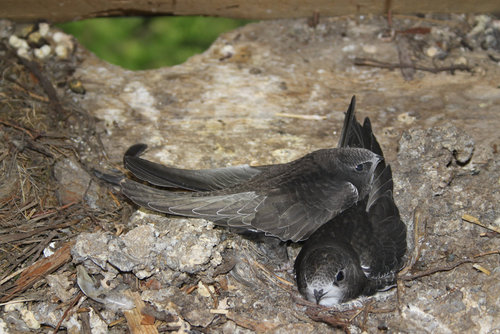
In cities, the endangered common swift nests in cracks in walls and under roofs.
The influence of fireworks on the swift is not sufficiently known. Photo Přemysl Tájek.
Several specific events can be mentioned. The New Year firework display in 2013 in Prague on the Vltava river, when the fireworks fired from a pontoon directly on the water caused injuries and deaths of birds, is well known, as the birds fell directly among the audience (Anonymous 2013). Another case happened around Beeb, Arkansas, in 2010, where about 5,000 birds fell in a square mile at around midnight on New Year’s Eve, specifically red-winged blackbirds, common starling, common grackle and brown-headed cowbirds. Birds crashed into cars, trees and buildings. Directly before the event there were strong explosions from the fireworks as part of the New Year celebrations (Choi 2011). The negative impact of fireworks on nesting least terns was described in New Jersey, when fireworks let off more than 250 m from the nesting colony caused the nests to be abandoned permanently. Temporary abandonment of the nest and stressed behaviour was observed in a colony at 1.2 km from the fireworks (Anonymous 1997). Piping plovers and black skimmers were also disturbed. A video of the great tit, taken during a firework display, also gives an insight into the impact of fireworks on small birds. The video clearly shows the considerable stress the birds have to face in a firework display (web1).
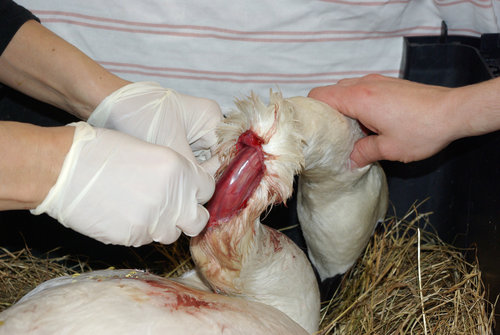
Mute swan with a cut wound to the neck after flying into tram lines due
to fireworks 2014. Photo Rescue Centre for Wild Animals of the Capital City of Prague
From the above it is clear that holding fireworks and pyrotechnic entertainment has a major negative impact on birds, which can be felt hundreds of metres to kilometres away. It includes stress reactions, the consequences of which can be even fatal. Due to fireworks, birds can abandon shelters, nests with chicks, collisions with obstacles can occur, and subsequent excessive predation cannot be ruled out. The risks caused by fireworks are usually intensified by the night time, when birds’ spatial orientation is less effective. It is practically impossible to define a period when fireworks would not have a negative impact on birds. Over the course of the year, birds are increasingly burdened with their energy-intensive biological needs (nesting, overwintering, migration or moulting). Thus, fireworks always have a negative effect on birds.
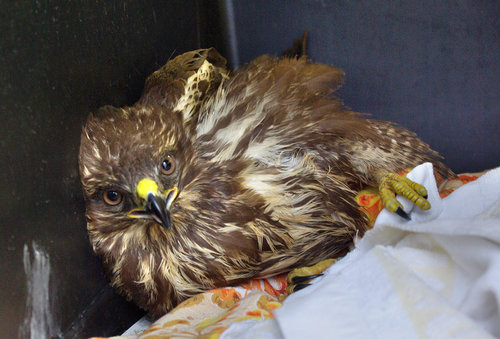
Common buzzard with physical injury after hitting an obstacle. Found in
the forest after New Year celebrations 2019. Photo Rescue Centre for Wild
Animals of the Capital City of Prague
Legal aspect – specially protected bird species
From the legislative point of view, dealing with fireworks we must primarily address the possible impact on species of animals protected pursuant to § 50 ANLP together with the Decree of the Ministry of the Environment (MoE) No. 395/1992 Coll., where the species are listed in Annex III. We are of the opinion that, when knowing of the occurrence of any protected animal species for which the firework display would disturb its natural biological activities, vital functions, manifestations, or existence itself, especially in birds up to several kilometres away from the fireworks, the firework display is undoubtedly a disturbing influence, which is prohibited by the ANLP itself.
In order to carry out harmful activities, in this case firework displays, exemptions from the prohibitions for potentially affected species must be granted, in accordance with the procedure in § 56 of ANLP. Whether these species can actually be affected must be assessed by the nature conservation authority (e.g. the absence of migrants in winter, etc.). In doing so, the applicant may utilise the procedure in § 56 para. 1 of ANLP – request for provision of preliminary information on the harmfulness of the intended activity before submitting an application for exemption pursuant to § 56 ANLP. The provision of § 56 ANLP deals with granting exceptions for protected species (§ 56 para. 1 of ANLP), and also granting exemptions for species that are further protected in addition to special species protection under European Community law (§ 56 para. 1 and 2 of ANLP). Especially in birds, all species protected by Czech law are also protected under European Community law (Directive 2009/147/EC of the European Parliament and of the Council of 30th November 2009 on the Conservation of Wild Birds, the “Birds Directive”). Thus, when assessing an intention in a procedure for granting a generic exemption, it must first be assessed whether the conditions under § 56 para. 1 of ANLP are met. In the case of a firework display, its realisation would have to be other public interest prevailing over nature conservation interests. If these conditions are met, further steps must be taken in accordance with § 56 para. 2 of ANLP. An exemption pursuant to the first sentence (§ 56 (1) of ANLP) may be granted only if one of the reasons listed in paragraph 2 (§ 56 ANLP) is given, there is no other satisfactory solution, and the activity authorised will not affect the achievement or maintenance of the species’ conservation status (insurmountable legal conditions that must be met). One of the reasons under § 56 para. 2, letter c) is “... for other overriding reasons in the public interest, including those of a social or economic nature….” The nature conservation authority must address the question of whether all the conditions for authorising the firework display are fulfilled and whether the intended event falls under that reason. Other legal grounds in § 56 para. 2 of ANLP for the case of fireworks and protected bird species cannot be applied. 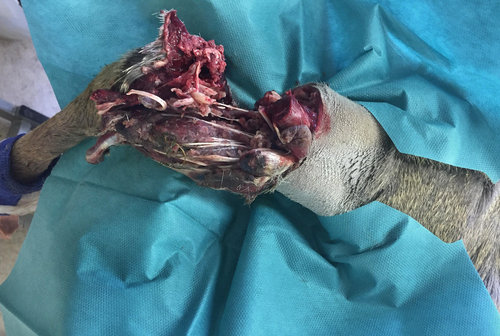
Fireworks can also have a negative effect on other, less observable animals.
Injured leg of a roe deer after colliding with a car during New Year's fireworks 2019.
However, it is difficult to prove the connection with fireworks.
Photo Rescue Centre for Wild Animals of the Capital City of Prague
Of course, there may be a situation where the presence of protected species at the locality is not known in advance, is subsequently confirmed, and at the same time the harmful impact of fireworks on them becomes known. The absence of knowledge of the occurrence of such species does not relieve the entity which carried out the harmful activity, from the responsibility for the offence in the fulfilment of the facts and of all the characteristics of the offence. An obligatory feature of the offence in the case of a legal entity (or a natural person as a business entity) in the vast majority of cases is that there is no fault. A negative effect on the individuals of the protected species present within the above collision distance (several kilometres) is highly likely to be expected.
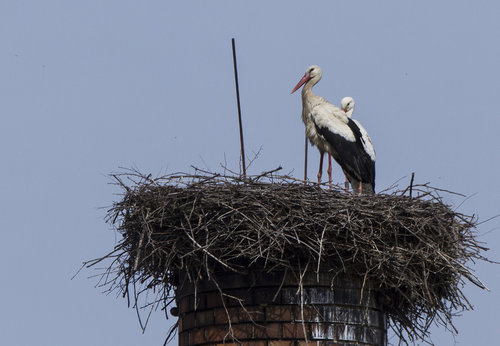
White storks nesting on chimneys in cities and villages are often the subject
of disputes in connection with fireworks. Photo Petr Lang
General protection of birds
Birds have an exceptional position in law compared to other species. In addition to specific species protection (§ 50 ANLP) they are, like all animals and plants, protected generally pursuant to § 5 ANLP, which mainly addresses protection at the population or species level. Beyond these provisions, birds, as the only group of organisms, enjoy protection according to § 5a and § 5b ANLP, due to the transposition of the Birds Directive (Articles 5, 6, 7 and 9) into national legislation. These provisions deal with the protection of individual birds.
In § 5a, the law addresses the protection of wild birds and clearly defines the deliberate negative interference in their lives. The fulfilment of the ‘intention’ in firework production will probably only be inferred if the organiser had a demonstrable knowledge of the harmful effect of the organised entertainment on the birds and, at the same time, the birds would actually be affected. Indeed, the condition of deliberate conduct may also be satisfied in the case of indirect intention. Indirect intent includes cases where the main purpose of the conduct was other than the killing of the birds or damage to their nests (typically by way of fireworks), but the perpetrator, in his indifference, consciously risked interference with the legally protected interest, even though he was aware of the potential violation. Awareness of risk is thus a decisive factor in assessing intention. Not every disturbance is prohibited by § 5a of ANLP (not within the framework of specific species protection, when it is completely prohibited). The disturbance must be significant in a sense of keeping the species population at an appropriate level. It is also necessary to take into account the abilities of the disturbed individual to deal with the disturbance (compare with § 50 and § 56 of the Act). It is therefore necessary to consider more strictly the disturbance at the time of mating, nesting or other extreme periods for birds.
Under the conditions for a different procedure for the protection of birds laid down in § 5b, the Act specifically lists the activities for which a different procedure may be established. A different procedure may be established in the interests of public health or public safety, in the interests of air safety, in order to prevent serious damage to crops, domestic animals, forests, fisheries and water management, or for the purpose of protection of wild fauna and flora, also for the purposes of research and teaching, of re-population of a certain area by a population of the species or re-introduction of the species in its original range, or for the breeding in human care for these purposes. Since the Act does not offer the possibility of granting an exemption for cultural events such as fireworks, the use of the authorisation process in the framework of bird protection under § 5a of the ANLP is virtually impossible. The use of the exemption procedure under § 5b of ANLP for generally protected bird species in the event of disturbance, which is significant for the conservation of the population of the species under the Birds Directive, is at the least highly questionable. As a result, if § 5a would be applicable to fireworks, it would never be possible to authorise fireworks.
General protection of plants and animals pursuant to § 5 of ANLP in the case of fireworks is also very limited in its applicability, because it mostly deals with harmful interventions that could endanger the existence of the species as such or its entire population. The application of this provision can be envisaged in the case of endangering a particular breeding colony of water birds, etc. In general practice, however, the general protection of plants and animals pursuant to § 5 of ANLP does not appear to be a suitable tool for legitimate legal restrictions on fireworks.
A little practical experience from the Czech Republic
The Czech Society for Ornithology (CSO) has been informing on the negative impact of fireworks on birds for years. Ornithologists have practical experience in protecting birds from fireworks, for example on the Vltava River in the centre of Prague. In May 2019, the CSO managed to get the planned fireworks on the Vltava, which was to be part of the Midsummer celebration NAVALIS, cancelled. The ornithologists pointed out the harmfulness of the fireworks to the nesting birds and stressed that there was a risk of the eggs and chicks in the nests cooling off, if their parents left them alone as they escaped from the fireworks. They addressed objections to the Mayor of Prague Zdeněk Hřib and asked him to cancel the planned fireworks. Due to the pressure from the public and the ornithologists, the organisers of the Midsummer Society completely cancelled the fireworks several hours before the planned event. A great turnaround in the issue of fireworks is the abolition of New Year fireworks in Prague, which should be replaced by videomapping, i.e. light projection on buildings. In August 2018 the Prague councillors decided to do this. The negative effect on animals was given as a reason. Brno’s Liberty Square is also scheduled to be without fireworks on New Year’s Eve 2019/2020 (web2). The use of fireworks, at varying degrees, is restricted by a number of generally binding decrees of municipalities and cities (e.g. České Budějovice, Česká Lípa, Hodonín, Mikulov, Pardubice).
Conclusion
Given the apparent negative impact of fireworks on animals, namely birds, a systematic restriction on firework displays at the national level would be most appropriate. One of the first steps may be, for example, a total ban on fireworks that have an acoustic effect. This may be followed by measures to restrict pyrotechnics and fireworks, e.g. limitation of the time period of sale, definition of a narrow time period of possible usage, or replacement by less intrusive alternatives (e.g. videomapping). We see positive examples in many places in the Czech Republic and abroad, when the issue of fireworks is the subject of discussion and there is a gradual increase in awareness of the negative effects of fireworks and in their restriction. It is becoming apparent that politicians and the public are increasingly aware of the dark side of costly firework displays, which are not so essential for citizens, who could quite easily live without them. This is confirmed by the experience of the Czech Society for Ornithology and ANP CR, to whom more and more people are turning with their concerns over fireworks.
Notes
1AOPK ČR, RP Správa CHKO Slavkovský les, Hlavní 504, 353 01 Mariánské Lázně
2AOPK ČR, RP Správa CHKO Slavkovský les, Závodu míru 725/16, 360 17 Karlovy Vary
3Česká společnost ornitologická, Na Bělidle 252/34, 150 00 Smíchov, Praha 5
A list of recommended literature is attached to the web version of the article at
www.casopis.ochranaprirody.cz

